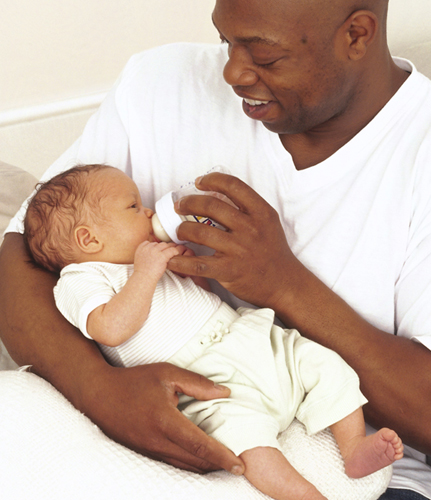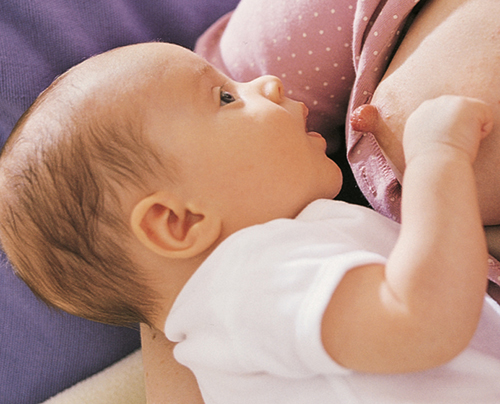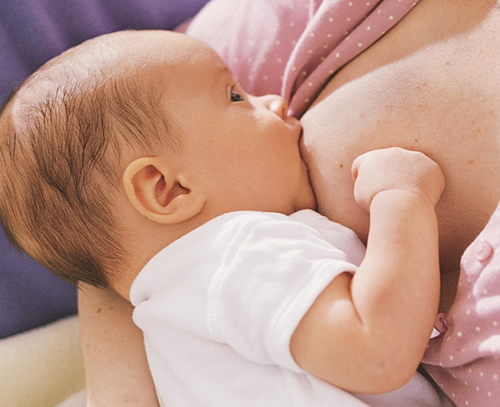Bottle-feeding
This involves more
preparation, but your partner can help and become involved with feeding.
You’ll need in advance 4–6 bottles: larger 8 fl oz (250 ml) bottles,
and smaller 4 fl oz (125 ml) ones; newborn bottle nipples; a bottle
brush; and infant formula. If you have chlorinated tap water, it’s okay
to put bottles in the dishwasher or wash by hand. Otherwise, clean all
of the parts, then boil in water for 5–10 minutes. Put filtered or
cooled boiled water in the bottle, then add the formula according to the
manufacturer’s instructions. Test the temperature of the milk by
squeezing a drop on your inner wrist: it should feel warm, but not hot.
Cool the milk if necessary by placing the bottle in a pitcher of cold
water, or running it under cold water while shaking the bottle all the
time. When ready, hold your baby half sitting with her head in the crook
of your elbow and her back along your forearm. Gently put the nipple
into her mouth and tip the bottle so the milk covers the nipple to stop
her from swallowing any air. Discard any formula leftover in the bottle.
Bottle-feeding helps dads strengthen the bond with their baby and allows you to have some welcome time off from feeding.

| Q: |
How often should I feed my baby?
|
| A: |
If you have a healthy, full-term baby, you should feed her on
demand, which means feeding her when she cries and seems hungry. This
can mean that sometimes she’ll be fed every couple of hours and
sometimes she’ll go for four to six hours without a feeding. Although
you may not feel as if you’re producing much milk initially, your baby
only needs small quantities of colostrum, the first watery milk. Her
demands will grow after the first few days, which will coincide with
your milk coming in (see When your milk comes in).
|
| Q: |
Will I be able to breast-feed my twins?
|
| A: |
Milk is produced on a supply and demand basis, so it’s perfectly
possible to breast-feed twins and more. If your babies are born early,
breast milk is beneficial since it protects against infections, which
premature babies are more susceptible to, so it’s worth breast-feeding,
even for a few weeks, but you’ll need rest and ample nutrition. Start by
feeding your twins separately. If you then want to feed them together,
take time to position them well. An under-arm hold works well (see Successful breast-feeding) and cushions and a willing helper are useful. Expressing
means the babies can be fed together, alternating on the breast. If you
think that they aren’t getting enough milk, consult your doctor. A
lactation consultant, La Leche League, or the local chapter of the
National Organization of Mothers of Twins Clubs can offer support too.
|
The right technique
Latching on
Taking the time to ensure that your baby is latched on
properly before a feeding is important because you could otherwise
develop sore nipples. A baby that is properly latched on has her mouth
wide open, with the whole areola (the area surrounding the nipple) in
her mouth; her bottom lip will be curled back and she will be noticeably
sucking. You’ll feel a sucking effect over the entire area.
Once you’ve positioned your baby so that she is level with your breast, hold her with her nose and mouth facing your nipple.

When your baby opens her mouth wide, bring her to the breast, ensuring that she takes all of the nipple and the areola into her mouth.

To remove your baby from the breast insert your finger into the corner of her mouth to break the seal so that she doesn’t pull the nipple.

Expressing milk
An extra supply
Expressing your milk boosts your milk production
and enables you to go out or have an unbroken night’s sleep while your
partner feeds the baby. You can express milk as soon as you like after
the birth, although often women wait until feeding is established, at
about four weeks. Your fresh milk can be stored in a milk-storage bag or
bottle for 3–8 days in the fridge or frozen for 3–6 months and
defrosted in the fridge or a bowl of warm water, never the microwave.
Many women use a breast pump, either electric or manual, to express milk. You can also express manually.